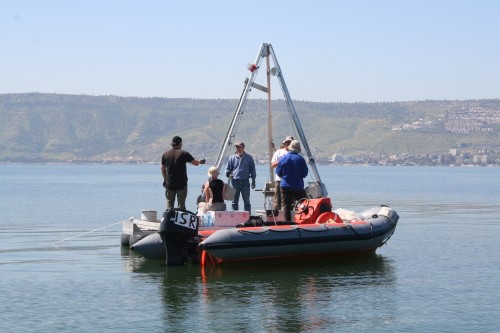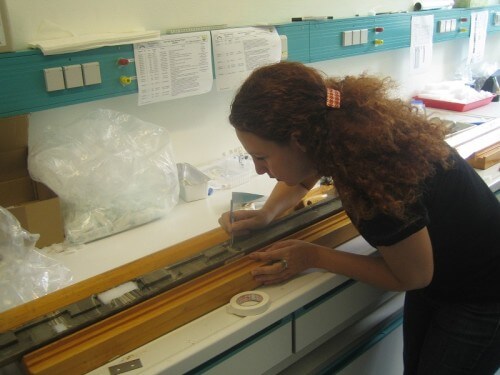A study of fossil grains of plant pollen extracted from the bottom of the Sea of Galilee revealed evidence of an acute climatic crisis that hit the Middle East from the middle of the 13th century to the beginning of the 11th century BC - and led to the collapse of the ancient empires of the Middle East.

A study of fossil grains of plant pollen extracted from the bottom of the Sea of Galilee revealed evidence of an acute climatic crisis that hit the Middle East from the middle of the 13th century to the beginning of the 11th century BC - and led to the collapse of the ancient empires of the Middle East. The results of the research are currently being published by Dr. Dafna Langut and Prof. Israel Finkelstein from the Department of Archeology at Tel Aviv University and Prof. Thomas Leith from the Steinman Institute for Geology, Mineralogy and Paleontology at the University of Bonn. Research partner Prof. Mordechai Stein from the Hebrew University of Jerusalem. The article is published today in the journal: Tel Aviv: Journal of the Institute of Archeology of Tel Aviv University
"In a short period of time, the whole old world of the Bronze Age collapsed," explains Prof. Finkelstein. "The Hittite Empire, the mighty Egypt of the Rameses pharaohs, the Mycenaean culture with its magnificent palaces in Greece, the copper powerhouse of Cyprus, the trading city of Ugarit and the other great port cities of Syria, the cities of the state of Canaan - all of this disappeared within a few decades, and from the ruins of the old world The kingdoms of the Iron Age grew, among them Israel and Judah."

The researchers, who drilled at a depth of about 300 meters of water in the heart of the Sea of Galilee, removed a core of soil about 20 meters long from the bottom of the lake, with the aim of sampling fossil grains of plant pollen from the sediment layers. "The pollen grains, the pollen, are the most durable organic material in nature," explains the palynologist (pollen researcher) Dr. Dafna Langut, who actually carried out the research. "The polen drifted to the Sea of Galilee with the winds and streams, and then sank from the surface of the lake to its bottom. These pollen grains can tell us about the vegetation in the Kinneret region in the past thousands of years and therefore about the climate that prevailed in the region." After carbon 14 dating of tens of thousands of pollen grains, the researchers identified a period of severe drought between 1250 and 1100 BC. A soil core extracted from the western shore of the Dead Sea revealed a similar picture.
"The uniqueness of our study compared to other Polish studies conducted in recent years in the Middle East and in general," adds Prof. Finkelstein, "is that we worked with an unprecedented resolution of sampling every 40 years. Poles are usually sampled at intervals of hundreds of years, and this indeed makes sense if you are interested in questions related to prehistoric periods and glacial and interglacial cycles that prevailed in our regions. Since we set ourselves the goal of elucidating historical issues, accuracy was crucial. If we sampled the Polen in the Sea of Galilee every 200 years, for example, it is possible that this dramatic climate crisis, which lasted 150 years, would have escaped our notice."
Another innovation in the current study is the complete chronological match between the results of the Poland study and two other pieces of evidence about the past: the destruction by fire of cities in the eastern Mediterranean area, many of them in the Land of Israel, also dating to the period between 1250 and 1100 BC, as well as spatial documents The ancient Middle East - from the Hittite capital in Anatolia in the north, through the port city of Ugarit in Syria and Tel Afek in Israel to Pharaonic Egypt in the south - speak of droughts and famine in the exact same period of time.
Langut, Finkelstein and Lit believe that severe cold waves destroyed the crops in the northern regions and the depletion of the rains damaged the crops in the Safar regions in Eastern Anatolia and Syria. "The cold waves in the north and the drought in the east caused large groups of people to be displaced from their place of residence and move south in search of food sources," explains Egyptologist Shirley Ben Dor Evin from the Department of Archeology at Tel Aviv University. These groups, among them the famous "sea heathens", moved on land and sea, looting cities and damaging the trade routes, which caused a deep economic and political crisis that gradually spread southward - also to the Land of Israel. "Everyone fought everyone else for ever-increasing resources," says Ben Dor.

8 תגובות
Finkelstein as usual attaches his invented theories to findings that do not even match in terms of dating.
Those who want will be fed, those who don't want won't be fed. successful method.
I will wait to hear explanations from respected archaeologists who respect us, the non-archaeologists but history buffs.
Note a question for Egyptologist Ben Dor.
If it is true that these huge waves of immigration, and the destruction of established and old nations, were caused by a war over resources that were being exhausted, how is it that other archaeologists claim that the Philistines, or the Sea Peoples, made a violent conquest and burned the rich cities to the ground. However, they did not try to inherit the wealth of the previous inhabitants of the city, and instead established inferior settlements, nearby, according to the researchers, this symbolizes the terrible contempt that the Sea Gentiles felt towards the cities and towards what they symbolized.
If resources were indeed lacking, no one would burn down a city if they could continue to exploit it.
Amit,
An interesting point. But it is written that the eruption happened around 1600 BC plus or minus 50 years. An interval of 400 years seems to me too far in relation to the figure of only 150 years of climatic damage between 1250 and 1100 BC.
ארי
The situation is the opposite. Those who do not believe in man-made warming are the religious. They make hypotheses that contradict the observations, attack the scientists on a personal level, and also, in many cases, simply lie.
Think about it... it's just like religion. Believe in something, adapt the observations to the belief, and anyone who thinks otherwise is corrupt...
You forgot the volcanic eruption that destroyed the Minoan culture. It may also have been the catalyst for this climate change by shifting the weather feedback loop.
http://en.wikipedia.org/wiki/Minoan_eruption
Eric, this whole thesis is beautiful and interesting, only there is a small difference between the prophets of that time and the scientists of today. The scientists rely on scientific findings and not on imagination, past experience or anything else irrelevant as the prophets relied on.
Even then the prophets (scientists) blamed man for the weather changes. The waves of drought and cold, the fickle weather and diminishing food sources were (and are) the result of man corrupting and polluting (fornication) the land.
Sound familiar? Global warming theories are the new religion in which God is mother earth, and it covers the man who corrupts and pollutes the earth. Another parallel is the attempt to produce facts by castrating the thinking person - "indisputable". Religious exemplification in which anyone who dares to suggest a different direction suffers from professional isolation and in some cases may lose his job. He also receives derogatory names such as capitalist pig, global warming denier (borrowed from a holocaust denier), fascist, etc. All this kills any discussion on the subject and only those who are true to their own truth survive. Oh, and I forgot the money they are trying to milk from us "at all costs", thus Greenpeace collects more billions, more money is invested in environmental politics, and of course there is no money without their hand being chained to the pocket of the working person.
sad!
Before the keyboard hero pounces - I still haven't said that there is no content in the claims of today's thinkers. I just expressed sorrow for the conduct of the Catholic Church around the issue!
Did the biblical author who dated the Exodus from Egypt and Joshua's conquests to this period know what he was talking about?